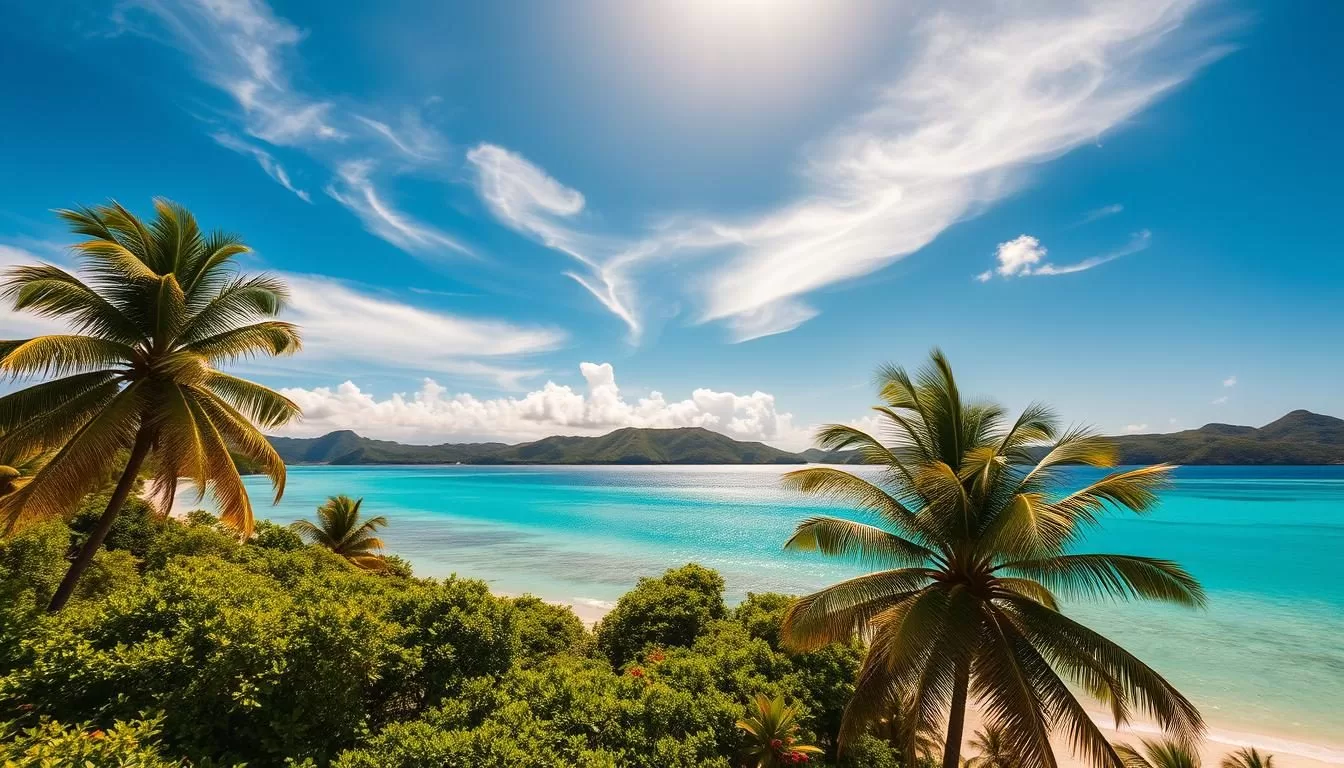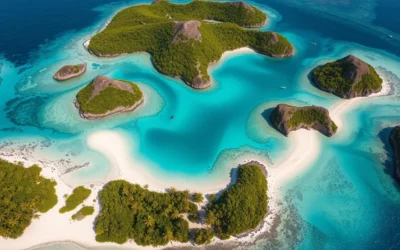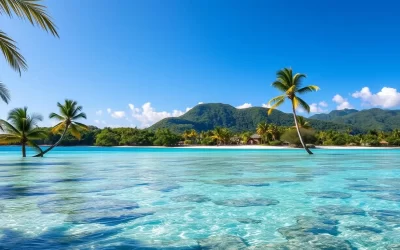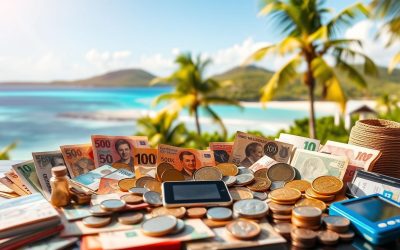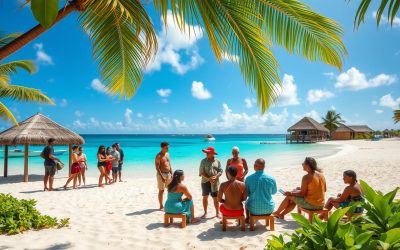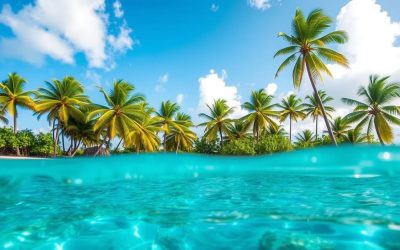Planning a trip to the remote Cocos (Keeling) Islands requires understanding the unique tropical climate patterns that affect this Indian Ocean paradise. The climate is warm, oppressive, extremely windy, and mostly cloudy throughout the year.
The temperature typically varies from 77°F to 85°F over the course of the year and is rarely below 75°F or above 87°F. To make the most of your trip, it’s essential to identify the best time to visit based on detailed weather analysis and seasonal patterns.
By understanding how the islands’ consistent temperature, varying rainfall, wind conditions, and humidity levels impact your travel experience, you can plan a perfectly timed visit to this tropical destination.
Discovering the Cocos (Keeling) Islands Climate
Understanding the climate of Cocos (Keeling) Islands is crucial for planning a successful trip. The islands’ unique geographic location in the Indian Ocean significantly influences their climate, making it essential to understand these conditions for a memorable visit.
Geographic Location and Climate Overview
The Cocos (Keeling) Islands are situated approximately 2,750 kilometers northwest of Perth, Australia. This remote location in the Indian Ocean gives the islands a tropical climate with minimal seasonal variation. The climate is characterized by warm temperatures and high humidity throughout the year. Based on the beach/pool score, the best time to visit Cocos Islands for hot-weather activities is from early July to mid-January.
| Period | Weather Conditions | Activities |
|---|---|---|
| July to January | Warm, dry, and sunny | Snorkeling, diving, kayaking |
| January to July | Warm, wetter, and more humid | Exploring marine ecosystems, local festivals |
Why Weather Matters for Your Visit
Weather conditions significantly impact the accessibility and enjoyment of the islands’ main attractions, including world-class beaches and coral reefs. Certain outdoor activities are heavily dependent on specific weather conditions for both safety and optimal experience. Understanding seasonal patterns helps you pack appropriately and plan suitable activities. Moreover, weather variations can affect flight reliability to this remote destination. Local festivals and events are often scheduled around optimal weather periods, providing additional reasons to time your visit strategically.
Year-Round Temperature Patterns
The Cocos (Keeling) Islands boast a remarkably stable climate throughout the year. This stability is a significant factor when planning your trip, as it allows you to focus on other aspects of your visit without worrying about extreme temperature fluctuations.
Average Monthly Temperatures
The average monthly temperatures in the Cocos (Keeling) Islands are consistently warm, ranging from 24 to 30 degrees Celsius. Historical temperature data shows that the average temperature remains relatively constant, with minimal variation from month to month. This consistency means that you can expect a comfortable temperature regardless of when you visit.
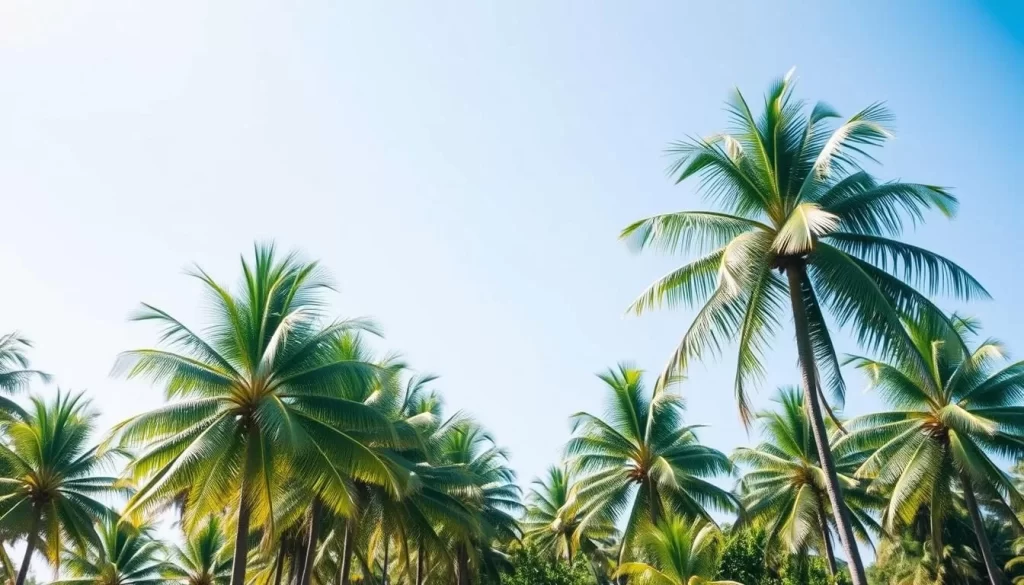
Temperature Consistency Throughout the Year
The temperature in Cocos Islands varies so little throughout the year that it is not entirely meaningful to discuss hot and cool seasons. You can enjoy water-based activities throughout the year without experiencing “too cold” periods. The islands’ consistent warmth and temperature stability make long-term trip planning more reliable. Factors like rainfall and wind have a more significant impact on your experience than temperature differences.
- Remarkable temperature consistency year-round
- Thermal comfort is relatively predictable
- Minimal variation in temperature patterns from year to year
- Consistent warmth for water-based activities
- Subtle temperature differences correlate with other weather factors
Rainfall and Wet Seasons
When planning your trip to the Cocos (Keeling) Islands, it’s essential to consider the rainfall and wet seasons to make the most of your visit. Understanding these patterns will help you prepare for the conditions you’ll encounter during your stay.
Wetter Season: January to July
The wetter season in Cocos (Keeling) Islands spans from January to July, during which the islands experience a significant portion of their annual rainfall. This period is characterized by increased precipitation, with some months seeing more frequent rain showers.
Key characteristics of the wetter season include:
- Increased rainfall, contributing substantially to the annual total
- Higher humidity levels, making the atmosphere feel more tropical
- Potential for brief, heavy downpours that can impact outdoor activities
Drier Season: July to January
The drier season, which lasts from July 21 to January 16, offers more favorable conditions for outdoor exploration and activities. September stands out as the driest month, with an average of just 3.2 days of precipitation and a total rainfall of 1.2 inches.
| Month | Average Rainfall (inches) | Average Wet Days |
|---|---|---|
| September | 1.2 | 3.2 |
| July | 2.5 | 5.1 |
| January | 4.8 | 8.3 |
During this drier period, you can expect more comfortable conditions for land-based activities and sightseeing, along with excellent water visibility ideal for snorkeling and diving adventures.
Sunshine Hours and Cloud Cover
When planning your trip to the Cocos (Keeling) Islands, understanding the patterns of sunshine and cloud cover is crucial for making the most of your time on the islands. The amount of sunshine and cloud cover varies throughout the year, impacting your travel experience.
Clearest Months: June to November
From June to November, the Cocos (Keeling) Islands enjoy clearer skies, making these months ideal for sun-related activities. During this period, you can expect more sun and longer periods of sunshine, with an average of more hours of direct sunlight per day. This is a great time for outdoor activities like snorkeling, diving, or simply enjoying the beautiful beaches.
Cloudier Period: November to June
The cloudier part of the year begins around November 1 and lasts for 7.6 months, ending around June 19. April is the cloudiest month, with the sky being overcast or mostly cloudy approximately 66% of the time. Despite the increased cloudiness, the temperatures remain warm and comfortable due to the islands’ tropical location. The cloud cover provides welcome relief from direct sun exposure, making outdoor exploration more comfortable during midday hours. Using reliable data, you can plan your activities accordingly and make the most of your trip.
Wind Conditions Throughout the Year
The wind conditions in the Cocos (Keeling) Islands change significantly over the course of the year. Understanding these changes is vital for making the most of your visit.
Windier Season: April to December
From April to December, the Cocos (Keeling) Islands experience their windier season. During this period, you can expect higher wind speeds that may impact certain activities. Data indicates that this windier season lasts for approximately 8 months, making it a significant part of the year.
The average wind speed during these months is notably higher, affecting water activities and outdoor experiences.
| Month | Average Wind Speed (mph) |
|---|---|
| April | 15.0 |
| May | 16.0 |
| June | 17.0 |
Calmer Period: December to April
The calmer time of the year, lasting 4.5 months from December 5 to April 20, offers a tranquil experience. February stands out as the calmest month, with an average hourly wind speed of 11.0 miles per hour.
During this period, you can enjoy paddle boarding, kayaking, and other water activities in the calm waters. The morning hours are typically the most placid, with winds picking up slightly in the afternoons.
- The calm conditions make it ideal for water sports and activities.
- February is the most tranquil month, perfect for those seeking serene weather.
Humidity and Comfort Levels
Humidity plays a significant role in determining comfort levels during your visit to the Cocos (Keeling) Islands. The islands’ tropical climate is characterized by relatively high humidity throughout the year.
Understanding the Tropical Humidity
The comfort level is largely influenced by the dew point, which indicates how effectively perspiration can evaporate from the skin, thus cooling the body. Lower dew points feel drier, while higher dew points feel more humid. Unlike temperature, dew point changes more slowly, meaning a muggy day is usually followed by a muggy night.
Managing Humidity During Your Visit
To stay comfortable, consider several strategies. The reliable trade winds provide natural relief, especially during the windier months from April to December. You can also schedule strenuous activities for early morning or late afternoon to avoid peak humidity discomfort. Choosing accommodations with good ventilation or air conditioning is crucial for quality sleep, given the minimal drop in humidity overnight. Additionally, wearing lightweight, loose-fitting, quick-drying clothing made from natural fibers like cotton or linen can significantly improve your comfort.
- The islands’ trade winds help evaporate perspiration, providing relief.
- Scheduling activities around peak humidity can enhance comfort.
- Accommodations with good ventilation or air conditioning improve sleep quality.
- Lightweight, natural fiber clothing enhances comfort in tropical conditions.
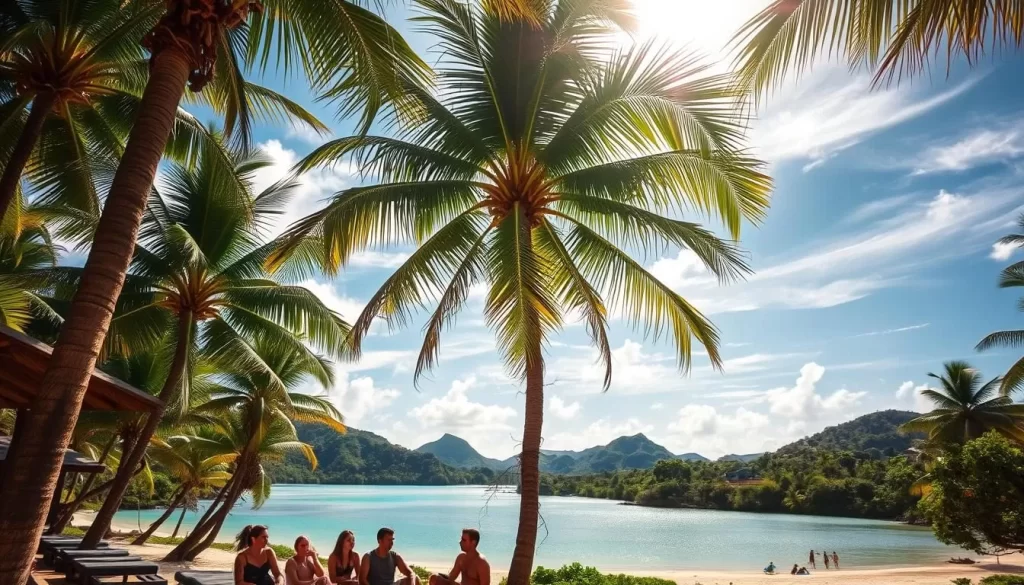
Ocean and Water Temperatures
Understanding the ocean and water temperatures is essential for planning your trip to the Cocos (Keeling) Islands. The islands’ marine environment is characterized by warm and relatively stable water temperatures throughout the year, making it an ideal destination for swimming and other water activities.
Best Months for Swimming and Water Activities
The water temperature in the Cocos (Keeling) Islands remains pleasant year-round, but certain months are better suited for swimming and water activities. The period from July to January is considered optimal due to clear, rainless days with perceived temperatures between 75°F and 90°F, peaking in the second week of October.
During this time, the sea is particularly inviting, making it perfect for snorkeling, diving, and other marine activities. You can enjoy the warm waters without the discomfort of high humidity or extreme temperatures.
Water Visibility and Marine Life Considerations
Water visibility varies significantly throughout the year, primarily influenced by rainfall patterns. The best underwater visibility occurs during the drier months from August through November, when reduced rainfall minimizes sediment runoff. This period offers excellent conditions for observing the diverse marine life, including coral reefs and various fish species.
While marine life diversity remains consistent year-round, certain species exhibit seasonal behaviors. For instance, coral spawning events typically occur during November or December around the full moon, offering a unique experience for visitors. The combination of favorable water temperature, visibility, and marine life activity makes September and October particularly outstanding months for snorkeling and diving experiences.
Cocos (Keeling) Islands: Best Months for a Weather-Savvy Trip
When planning a trip to the Cocos (Keeling) Islands, understanding the best time to visit is crucial for a memorable experience. The islands’ weather patterns vary throughout the year, making some months more ideal for certain activities.
July to January: Optimal Weather Conditions
The period from July to January is considered optimal for visiting the Cocos (Keeling) Islands due to the drier weather conditions. During these months, you can expect less rainfall and more sunshine, making it ideal for outdoor activities such as snorkeling and diving. The water temperature remains comfortable, around 80°F to 82°F, perfect for water activities. This period is generally considered the best time for a visit, with favorable weather conditions.

February to June: What to Expect
From February to June, the Cocos (Keeling) Islands experience their wetter season, with increased rainfall and humidity. However, this period still offers unique advantages for certain types of visitors. You can expect fewer tourists, potentially resulting in lower accommodation prices and a more secluded experience. Despite the increased rainfall, precipitation usually occurs in short bursts, leaving plenty of sunshine between showers. The slightly warmer water temperatures during this period, peaking around 83°F in March, create comfortable conditions for swimming and water activities. Wildlife enthusiasts may appreciate this period as the increased rainfall creates lush vegetation and more active terrestrial ecosystems.
Planning Your Visit by Season
When planning your trip to the Cocos (Keeling) Islands, understanding the seasonal variations can significantly enhance your travel experience. The islands offer different activities and attractions throughout the year, making it crucial to choose the best time to visit based on your preferences.
Dry Season Activities and Attractions
The dry season, spanning from July to January, is characterized by clearer skies and less rainfall, making it ideal for outdoor activities such as snorkeling, diving, and exploring the islands. You can enjoy water sports and activities without the hindrance of rain on most days.
- Explore the pristine beaches and crystal-clear waters.
- Engage in activities like kayaking, paddleboarding, or simply enjoying the sun.
- Visit the Cocos Malay Cultural Centre to learn about the local heritage.
Here’s a snapshot of what to expect during the dry season:
| Month | Average Rainfall | Average Sunshine Hours |
|---|---|---|
| July | 100 mm | 8 hours |
| August | 80 mm | 9 hours |
| September | 60 mm | 9 hours |
Wet Season Opportunities
Despite being the wetter period, the season from February to June has its unique charm, with lush vegetation and fewer tourists, making it a great time visit for those on a budget or seeking a more secluded experience. The rain showers are often followed by sunshine, allowing for a mix of indoor and outdoor activities.
- Enjoy the lush landscapes and vibrant flora.
- Take advantage of lower prices for accommodations and tours.
- Experience the local culture through indoor activities like cooking classes or cultural workshops.
For those planning their travel to the Cocos (Keeling) Islands, understanding these seasonal variations is key to making the most of your trip. Whether you prefer the dry season’s clear skies or the wet season’s lush landscapes, there’s a best time for everyone.
Packing Tips Based on Weather Conditions
Packing for the Cocos (Keeling) Islands requires a thoughtful approach, considering the varying weather conditions throughout the year. Understanding the climate and potential weather extremes during your visit will help you prepare a more suitable luggage list.
Essential Items Year-Round
Regardless of the time of year you visit, there are certain essentials that should always be included in your packing list. Waterproof footwear that dries quickly is a must, given the tropical environment and potential for rain. Comfortable, breathable clothing is also crucial for managing the humidity and temperature. Don’t forget to pack sun protection, including sunscreen, a hat, and sunglasses, as the sun’s reflection off the water can be intense.
- Lightweight, quick-dry clothing
- Waterproof or water-resistant jacket
- Sunscreen and sun protection accessories
- Comfortable, waterproof footwear
Seasonal Additions to Your Packing List
The specific weather conditions during your visit will dictate additional items to include. For instance, during the wetter season (February to June), it’s wise to pack extra quick-dry clothing and a lightweight waterproof jacket. If you’re visiting during the windier months (April to December), secure hat straps and windbreakers will be useful. For the dry season (July to January), especially during the peak dry months (August to October), extra sun protection is advisable due to clearer skies and reflective water surfaces.
- For wetter days: umbrella, waterproof bags
- For windier days: secure hat straps, windbreakers
- For dry, sunny days: extra sunscreen, lip balm with SPF
By tailoring your packing list to the expected weather conditions during your travel dates, you can ensure a more comfortable and enjoyable trip to the Cocos (Keeling) Islands, making the most of your days there.
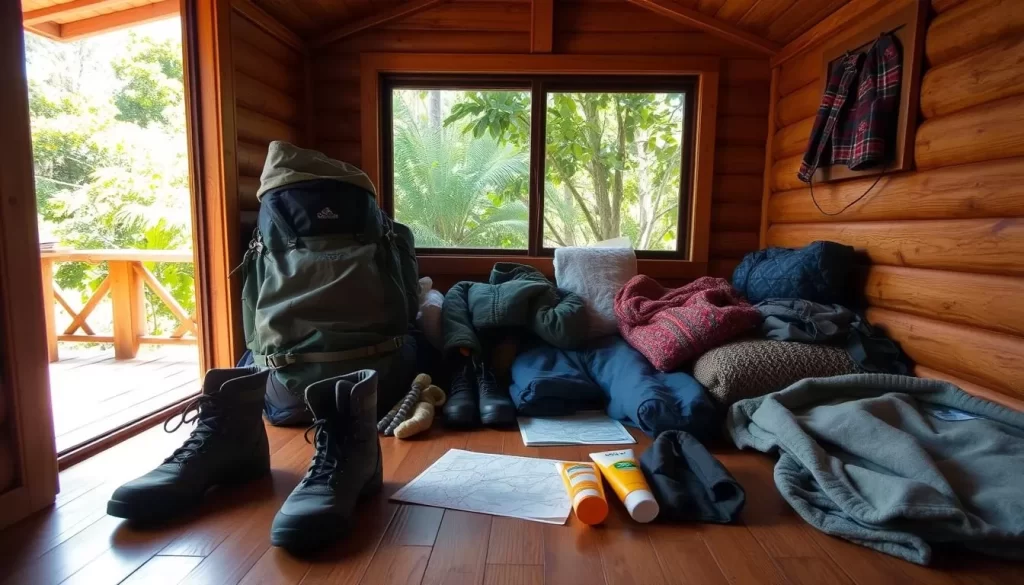
Weather Monitoring and Resources
To stay informed about the weather in Cocos (Keeling) Islands, you need to know where to look. Reliable weather information is crucial for planning a successful trip.
Reliable Weather Forecasts for the Islands
For accurate and up-to-date weather forecasts, it’s recommended to consult multiple data sources. Historical weather data provides valuable context for understanding what to expect during your planned visit dates. Climate charts showing monthly averages for rainfall, temperature, and wind speeds help identify the optimal timing for your specific activity preferences.
Understanding Weather Patterns Before Your Trip
Consulting multiple data sources is recommended as weather patterns in remote locations like the Cocos (Keeling) Islands can sometimes vary from historical norms. Seasonal weather phenomena, such as the Indian Ocean Dipole, can influence conditions, making recent trend analysis valuable for trip planning. Connecting with recent visitors through travel forums provides real-world insights that complement official weather data and forecasts.
By leveraging these resources, you can make informed decisions about your travel plans and ensure a more enjoyable trip.
Conclusion: Making the Most of Your Weather-Savvy Trip
The islands’ consistent temperatures make them a great destination year-round. While the period from July to January offers the most favorable overall weather conditions, being flexible with your daily activities based on current weather will maximize your enjoyment. Understanding the islands’ weather patterns allows you to appreciate each season’s unique characteristics. By connecting with local knowledge upon arrival, you can gain valuable insights into micro-climates and activity recommendations. Ultimately, the Cocos (Keeling) Islands are worth visiting at any time, with weather knowledge enhancing your experience.
The above is subject to change.
Check back often to TRAVEL.COM for the latest travel tips and deals.
